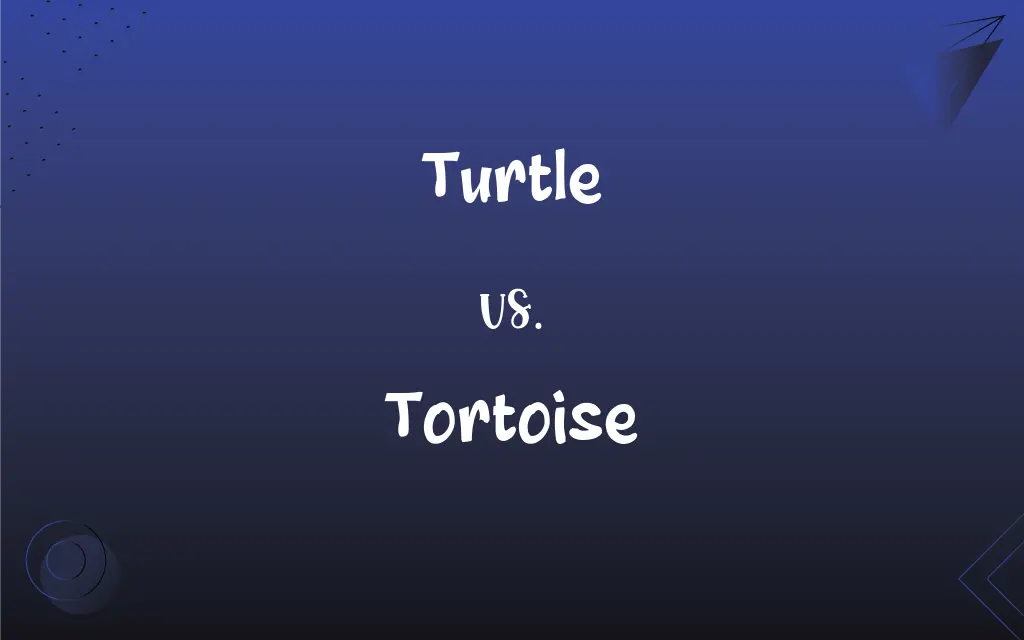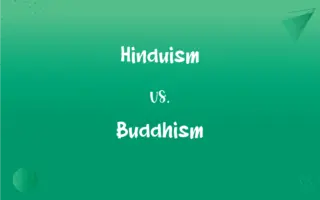Turtle vs. Tortoise: What's the Difference?
Edited by Janet White || By Harlon Moss || Updated on June 26, 2024
A turtle primarily lives in water and has a flatter shell, while a tortoise is land-based with a dome-shaped shell.

Key Differences
A turtle is a reptile that typically has a flatter shell and webbed feet designed for swimming. A tortoise, in contrast, boasts a more dome-shaped shell and sturdier, stockier legs adapted for land movement.
While both turtles and tortoises belong to the order Testudines, their habitats are distinct. Turtles primarily occupy aquatic environments, while tortoises are more adapted to terrestrial environments.
In terms of diet, turtles often consume a mix of plants and small aquatic animals. Tortoises, depending on the species, are generally herbivorous, feasting on grasses, fruits, and plants.
The lifespan of these creatures also offers distinctions. While many turtle species can live for several decades, many tortoise species have the potential to surpass a century, with some living for over 150 years.
Another notable distinction between turtles and tortoises is their behavior. Turtles, being aquatic, may migrate long distances in oceans, whereas tortoises, being land-dwellers, might dig burrows for shelter or hibernation.
ADVERTISEMENT
Comparison Chart
Habitat
Primarily aquatic
Primarily terrestrial
Shell Shape
Flatter shell
Dome-shaped shell
Feet
Webbed for swimming
Sturdy, stocky for walking
Diet
Mix of plants and small aquatic animals
Mainly herbivorous (grasses, fruits, plants)
Lifespan
Several decades
Many species can live over a century
ADVERTISEMENT
Turtle and Tortoise Definitions
Turtle
A reptile with a shell and webbed feet, primarily aquatic.
The turtle swam gracefully through the clear water.
Tortoise
A terrestrial reptile with a dome-shaped shell.
The tortoise moved slowly across the meadow.
Turtle
An aquatic reptile that can pull its body into its shell for protection.
The turtle retreated into its shell when it sensed danger.
Tortoise
A creature known for its slow pace and long lifespan.
The tale of the tortoise and the hare emphasizes patience.
Turtle
A symbol of patience and longevity in various cultures.
In many myths, the turtle carries the world on its back.
Tortoise
A symbol of persistence and determination in various tales.
The story highlights the tortoise's perseverance over speed.
Turtle
A creature with a bony or cartilaginous shell.
The child was fascinated by the turtle's protective shell.
Tortoise
A herbivorous reptile with a sturdy shell.
The tortoise munched on the fresh green grass.
Turtle
An animal belonging to the order Testudines.
Turtles have been on Earth for over 200 million years.
Tortoise
A land-dwelling animal from the order Testudines.
The Galápagos Islands are home to unique species of tortoises.
Turtle
Any of various aquatic or terrestrial egg-laying reptiles of the order Testudines (or Chelonia), having horny toothless jaws and a bony or leathery shell into which the head, limbs, and tail can be withdrawn in most species.
Tortoise
Any of various terrestrial turtles, especially one of the family Testudinidae, characteristically having thick clublike hind limbs and a high, rounded carapace.
Turtle
Any of various members of this order that live in fresh or brackish water, in contrast to the terrestrial tortoises.
Tortoise
One that moves slowly; a laggard.
Turtle
Chiefly British A sea turtle.
Tortoise
Any of various land-dwelling reptiles, of the family Testudinidae or the order Testudines , whose body is enclosed in a shell (carapace plus plastron). The animal can withdraw its head and four legs partially into the shell, providing some protection from predators.
FAQs
What environment do turtles primarily inhabit?
Turtles primarily live in aquatic environments.
Do turtles and tortoises both have shells?
Yes, both turtles and tortoises have protective shells.
Do tortoises have webbed feet?
No, tortoises have sturdy, stocky feet for walking on land.
Are tortoises mainly aquatic creatures?
No, tortoises are primarily land-based or terrestrial.
What's a common symbol associated with turtles?
Turtles are often symbols of patience and longevity.
Do tortoises swim?
Generally, tortoises are not adapted for swimming and are land-dwellers.
Are turtles and tortoises cold-blooded?
Yes, both turtles and tortoises are reptiles and are cold-blooded.
Can tortoises climb?
Surprisingly, some tortoises can climb obstacles, albeit not very high ones.
Do turtles breathe underwater?
While turtles can hold their breath for extended periods, they do need to surface for air.
Which has a flatter shell: turtle or tortoise?
The turtle typically has a flatter shell.
Can turtles live for over a century?
While some turtles live several decades, it's more common for tortoises to live over a century.
Which is more likely to migrate long distances: turtle or tortoise?
Turtles, especially sea turtles, are known to migrate long distances in oceans.
Is the tortoise's shell adapted for swimming?
No, the tortoise's dome-shaped shell is adapted for a terrestrial life.
Can you keep a tortoise as a pet?
Yes, many people keep tortoises as pets, but they require specific care and a suitable environment.
Are tortoises known for their speed?
No, tortoises are commonly associated with slow movement.
Can turtles retract into their shells?
Yes, many turtles can pull their bodies into their shells for protection.
Are there any famous tales involving a tortoise?
Yes, one of the most famous is "The Tortoise and the Hare," emphasizing the virtue of persistence.
Is the tortoise's diet mainly carnivorous?
No, tortoises are mainly herbivorous.
Are all turtles and tortoises from the same family?
Both turtles and tortoises belong to the order Testudines, but they are different families within that order.
Which is larger: turtle or tortoise?
It varies by species, but some tortoises can be much larger than most turtles.
About Author
Written by
Harlon MossHarlon is a seasoned quality moderator and accomplished content writer for Difference Wiki. An alumnus of the prestigious University of California, he earned his degree in Computer Science. Leveraging his academic background, Harlon brings a meticulous and informed perspective to his work, ensuring content accuracy and excellence.
Edited by
Janet WhiteJanet White has been an esteemed writer and blogger for Difference Wiki. Holding a Master's degree in Science and Medical Journalism from the prestigious Boston University, she has consistently demonstrated her expertise and passion for her field. When she's not immersed in her work, Janet relishes her time exercising, delving into a good book, and cherishing moments with friends and family.































































